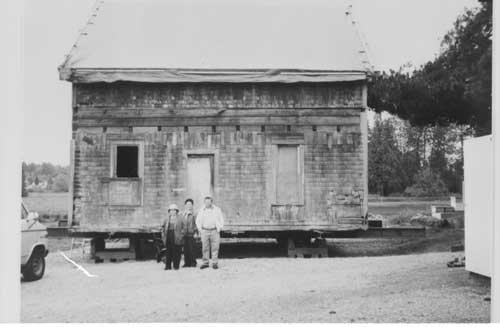Frederick W. Winter moved to Spokane from New York in 1906. He began working with Hoyt Brothers Florists, where he met Cecelia Roedel, the firm’s bookkeeper. The two married the following year.
1994.34.03 - Frederick & Cecelia Winters in Winters House. Circa 1935.
Frederick and Cecilia Winters settled in the Bellevue area in 1916, after purchasing a farm in the Mercer Slough. The Winters raised azaleas for sale in several greenhouses on the property, which was expanded in the early 1920s. Frederick Winters raised narcissus, Dutch irises, and Spanish irises.
“F. W. Winters, internationally known Bellevue bulb grower, recently purchased 60 acres in Mercer Valley, which he plans to eventually have in production. Twenty acres of this land is cleared and Mr. Winters plans to clear about ten more this summer.”
The Winters constructed their home in 1929 for $32,000. Cecilia's brother, Elmer H. Roedel, designed the home using the popular Spanish Eclectic style, and based it on his own home in Portland, Oregon. The decision to use this Spanish Eclectic style was influenced by the 1915 Panama-California Exposition in San Diego, as well as the architecture they enjoyed on a trip to Cuba.
1999.09.01 - The Winters House, 1930s.
“Fred W. Winters, pioneer florist in Mercer Valley, has just received eleven tons of King Alfred, Spring Glory, Emperor, Victoria and Golden Spur daffodil bulbs from Holland, which he will plant on his property south of the Factoria bridge. The magnitude of the order may be imagined when you realize that over 110,000 bulbs are included and the freight and import duty amounts to over $1500.
This lot which is now being booked under government supervision for sterilization is the first of three shipments. One of the shipments yet to come will include 20,000 fancy varieties of Dutch Iris bulbs. There are already a half a million Dutch Iris bulbs planted on the Winters’ Floral Farm.
These bulbs are imported under special government permit and are held in bond for a period of two years, after which they may be sold.
Mr. Winters was the first man to experiment with the Mercer Valley soil following the lowering of the lake and his pioneer efforts in the culture of this wonderful soil has induced many others to follow in it’s cultivation. The entire valley will some day be under intensive cultivation and no one can estimate it’s eventual value to the Bellevue District.”
In the early 1930s, the Winters property included additional bulb houses, guest residences, and multiple greenhouses. In 1937, a portion of the estate was sold to Endre Ostbo, who established a rhododendron business and built greenhouses.
The Winters sold the house and bulb house to Anna and Frank Riepl in 1943 for $40,000. They retired to Vashon Island and established a floral business specializing in carnations.
1994.34.01 - Winters House, 1940s.
1994.34.02 - Winters House, 1940s.
Winters House is one of the few buildings associated with the past agricultural activity in the Bellevue area that remains on its original site. Purchased by the City of Bellevue in 1988, the Winters House was restored to its 1929 original design. Through a project spearheaded by the Bellevue Historical Society, the house was listed on the National Register in 1992. It is the only building in Bellevue on the National Register of Historic Places.
The Bellevue Historical Society, which later became Eastside Heritage Center, moved into the renovated home, along with antique furniture donated by Bellevue residents and businesses. Since then, the City and EHC have partnered to provide programming, exhibits, and public access to the historic site.
The building was closed in 2016 for construction of the East Link Extension light rail project along Bellevue Way. Winter’s House remains closed due to construction.
Resources
Eastside Heritage Center Archives
Wikimedia Foundation. (2021, March 30). Frederick W. Winters house. Wikipedia. Retrieved January 4, 2022, from https://en.wikipedia.org/wiki/Frederick_W._Winters_House
Winters House. City of Bellevue. (n.d.). Retrieved January 4, 2022, from https://bellevuewa.gov/city-government/departments/parks/parks-and-trails/parks/winters-house















